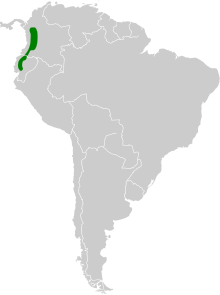The western emerald (Chlorostilbon melanorhynchus) is a species of hummingbird in the "emeralds", tribe Trochilini of subfamily Trochilinae. It is found in Colombia and Ecuador.[3][2]
| Western emerald | |
|---|---|

| |
| Male in NW Eduador | |
| Scientific classification | |
| Domain: | Eukaryota |
| Kingdom: | Animalia |
| Phylum: | Chordata |
| Class: | Aves |
| Clade: | Strisores |
| Order: | Apodiformes |
| Family: | Trochilidae |
| Genus: | Chlorostilbon |
| Species: | C. melanorhynchus
|
| Binomial name | |
| Chlorostilbon melanorhynchus Gould, 1860
| |

| |
| Synonyms | |
|
Chlorostilbon mellisugus melanorhynchus[2] | |
Taxonomy and systematics
editThe western emerald was originally described as a species and later treated as a subspecies of the blue-tailed emerald (Chlorostilbon mellisugus). Since the early 2000s the South American Classification Committee (SACC) of the American Ornithological Society, the International Ornithological Committee (IOC), and the Clements taxonomy have again treated it as a species in its own right. However, as of 2020 BirdLife International's Handbook of the Birds of the World (HBW) retained it as the C. mellisugus subspecies.[4][3][5][2]
The IOC treats the western emerald as monotypic.[3] The SACC and Clements recognize two subspecies, the nominate C. m. melanorhynchus and C. m. pumilus, though the SACC accepts that the latter "might not be recognizable".[6][5] HBW treats melanorhynchus and pumilis as subspecies of blue-tailed emerald.[2]
Description
editThe western emerald is 10.9 to 11.4 cm (4.3 to 4.5 in) long and weighs about 2.6 g (0.092 oz). Both sexes of both subspecies have a short black bill. The nominate male has an iridescent green forehead and crown with gold highlights, a bright green face, shining bronzy green upperparts, and a steel blue tail. Its underparts are glittering emerald green, with greater iridescence and a blue tinge on the breast. It has white thigh tufts. The female has a bronzy green forehead and crown and a blackish face with a pale gray spot behind the eye. The rest of its upperparts are metallic grass green and the tail is blue-black with white tips. Its underparts are pale gray to white with a buffy tone on the throat and belly. C. m. pumilus, when treated separately, differs only by having a slightly shorter bill and a brighter crown than the nominate.[7]
Distribution and habitat
editThe western emerald is found from the Western Andes of Colombia south into Ecuador. C. m. melanorhynchus occurs in the upper subtropical zone of Colombia and the temperate zone in Ecuador. C. m. pumilus is found at lower elevations, in the arid and semi-arid tropical and subtropical zones.[7] In Colombia it ranges between elevations of 1,000 and 2,000 m (3,300 and 6,600 ft).[8] In the northwestern Ecuadoran valleys it occurs between 1,500 and 2,700 m (4,900 and 8,900 ft) and mostly between 600 and 1,800 m (2,000 and 5,900 ft) elsewhere in Ecuador.[9] It has been recorded as low as sea level and as high as 3,050 m (10,000 ft).[7]
The western emerald inhabits open to semi-open landscapes such as the edges and clearings of mature forest, plantations, cultivated areas and fields, and gardens.[7]
Behavior
editMovement
editThe western emerald is generally sedentary but might make limited seasonal elevational changes.[7]
Feeding
editThe western emerald usually feeds at fairly low levels. Almost nothing else is known about its feeding strategy or diet because most observations are published as the blue-tailed emerald without distinguishing the subspecies.[7]
Breeding
editThe western emerald's breeding season in Colombia appears to span from January to June. As is the case with feeding, most observations of its breeding phenology are published as the blue-tailed emerald without distinguishing the subspecies.[7]
Vocalization
editThe western emerald's song is "a continuous series of subdued scratchy and wheezy notes... sometimes preceded by a few introductory notes, witsitsitsi...chirr..chirr..chirr..chirr.. or tsit-trr, tsit-trr, tsit-trr, tsit-trr...." Its calls include "a soft tsip, pit, and chwep."[7]
Status
editThe IUCN follows HBW taxonomy and so has not assessed the western emerald separately from the blue-tailed emerald. It "[r]eadily accepts man-made habitat and is fairly common across its range."[7]
References
edit- ^ "Appendices | CITES". cites.org. Retrieved 2022-01-14.
- ^ a b c d HBW and BirdLife International (2020) Handbook of the Birds of the World and BirdLife International digital checklist of the birds of the world Version 5. Available at: http://datazone.birdlife.org/userfiles/file/Species/Taxonomy/HBW-BirdLife_Checklist_v5_Dec20.zip [.xls zipped 1 MB] retrieved 27 May 2021
- ^ a b c Gill, F.; Donsker, D.; Rasmussen, P., eds. (January 2022). "Hummingbirds". IOC World Bird List. v 12.1. Retrieved January 15, 2022.
- ^ Remsen, J. V., Jr., J. I. Areta, E. Bonaccorso, S. Claramunt, A. Jaramillo, D. F. Lane, J. F. Pacheco, M. B. Robbins, F. G. Stiles, and K. J. Zimmer. Version 24 July 2022. A classification of the bird species of South America. American Ornithological Society. https://www.museum.lsu.edu/~Remsen/SACCBaseline.htm retrieved July 24, 2022
- ^ a b Clements, J. F., T. S. Schulenberg, M. J. Iliff, S. M. Billerman, T. A. Fredericks, J. A. Gerbracht, D. Lepage, B. L. Sullivan, and C. L. Wood. 2021. The eBird/Clements checklist of Birds of the World: v2021. Downloaded from https://www.birds.cornell.edu/clementschecklist/download/ Retrieved August 25, 2021
- ^ Stiles, Gary (2003). "Split Chlorostilbon mellisugus into three species". South American Classification Committee of the American Ornithological Society. Retrieved July 31, 2022.
- ^ a b c d e f g h i Bündgen, R., G. M. Kirwan, P. F. D. Boesman, and H. F. Greeney (2020). Western Emerald (Chlorostilbon melanorhynchus), version 1.0. In Birds of the World (S. M. Billerman, B. K. Keeney, P. G. Rodewald, and T. S. Schulenberg, Editors). Cornell Lab of Ornithology, Ithaca, NY, USA. https://doi.org/10.2173/bow.weseme1.01 retrieved July 31, 2022
- ^ McMullan, Miles; Donegan, Thomas M.; Quevedo, Alonso (2010). Field Guide to the Birds of Colombia. Bogotá: Fundación ProAves. p. 92. ISBN 978-0-9827615-0-2.
- ^ Ridgely, Robert S.; Greenfield, Paul J. (2001). The Birds of Ecuador: Field Guide. Vol. II. Ithaca: Cornell University Press. p. 257. ISBN 978-0-8014-8721-7.